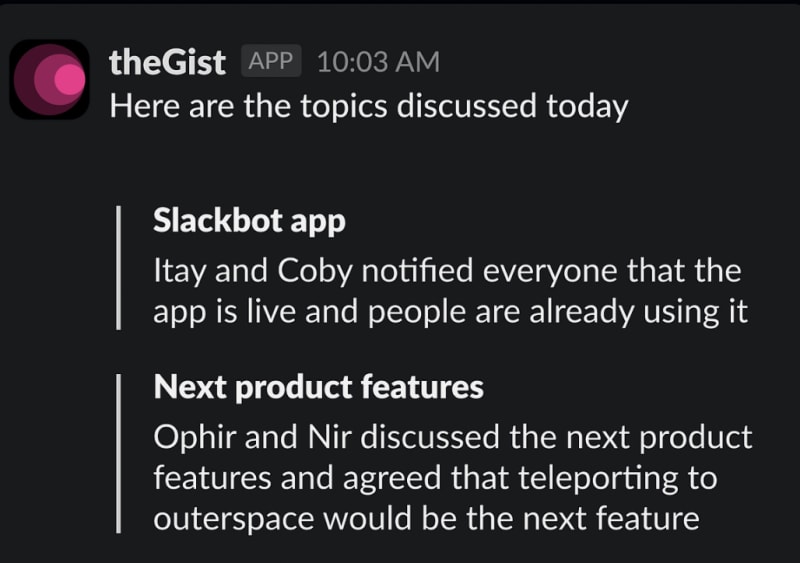An average Slack user gets bombarded with dozens - sometimes hundreds - of messages daily.
And let's face it, not all of them carry the same weight.
That's where the brilliance of a well-chosen Slack summary tool comes into play.
And trust me when I say, investing time in finding that 'Goldilocks' Slack summary tool - the one that fits just right - can be a game-changer for your team's collaboration and productivity. Let's get started.
You can always discover Slack Apps in the Slack App Directory.
Understanding Your Team's Needs
Who is it who needs the tool? Is your crew a compact startup team of ten or a sprawling corporate network in the hundreds? Do you work with a specialist software team, or a sales team, or do you have a variety of roles under one roof?
Lastly – what problem are you trying to solve? Do you have a simple use case, where you just want to summarise simple Slack threads, or are you looking for a fully-fledged collaboration tool that allows your team to surface insights and decisions from various tools that they would otherwise not have had access to, and solve communication issues inherent in the human condition?
These answers dictate the kind of tool you need.
What features do you need?
Summaries at the channel/thread level or team/project level?
The term 'summary' tool would be a misnomer if it doesn't provide you with summaries of some kind – but what exactly do you want to summarise?
Summarise at the team/project level: If communication and collaboration are a pain point, or you want cross-functional collaboration or a tool that keeps people on the same page.
Summarise at the channel/thread level: If there is no need or appetite for a tool that keeps people on the same page, or has a very simple use-case, such as someone who wants to save a bit of time.
Integrations with other tools?
Depending on your team's function and tools, your tool should summarise more than Slack.
Tool overload is a real issue in the digital workspace, though, so it might be important not to add another standalone tool to your stack.
You just want Slack: Slack is your only collaboration tool, and it would be overkill to integrate with others.
You want cross-platform context: Perhaps you want threads from multiple tools all in one place, or want actionable insights or suggestions from across your tools.
Memory?
There is a big difference between different classes of Slack summary apps. Many are thin layers between your Slack data and an LLM, like ChatGPT. And for some use cases, that can be enough. Not every team is looking for a complete collaboration tool.
Short-term context: Good for saving time in simple use cases. Simply summarises the content of recent Slack messages, either in Slack channels or Slack threads.
Memory capability: Can form a long-term memory of the context and activity of what happens. Highly beneficial for teams with high-volume updates or complex cross-functional activities. Perfect for the “information overload” use case.
Data privacy?
This will be non-negotiable for many larger teams or companies in regulated spaces. Ensure the companies behind tools have watertight privacy and security practices.
While the right tool can optimise your team's efficiency, it shouldn't come at the cost of compromising sensitive information.
Three Slack summary extensions for different use cases
Here are three of the best-in-class tools depending on your needs and use case. However, there are more tools.
Here’s a guide to the 6 best Slack apps and integrations for software teams.
TLDR
TLDR is the simplest summary tool. It uses generative AI through large language models (LLMs) to summarise long Slack messages and threads into brief, comprehensible summaries via a straightforward slash command.
While it lacks long-term memory, deep context or tool integration, TLDR can present the crux of long conversations efficiently. It isn’t specifically built with privacy in mind, though.
Good for: TLDR fits the bill for businesses and teams across various sectors that predominantly rely on Slack for their internal communication and simply want to save some time reading. As its capabilities are strictly limited to Slack, teams operating with a broader array of communication tools might find its utility somewhat restricted.
CollabGPT
CollabGPT is at the other end of the spectrum. It is a powerful, secure collaboration tool that not only offers summaries aided by long-term memory and can suggest actionable next steps and answer pressing questions. It integrates with tools like Slack, Jira, GitHub and more.
Where CollabGPT gains an edge over other summarisation tools is its sophisticated AI architecture. It can get a deep understanding of your project context and goals.
Good for: Teams who want to collaborate better – especially software and product teams. It keeps track of everything happening around you so you can make better decisions. Its prowess lies in its deep "memory" and seamless integration with popular platforms used by software and product teams like Jira, Slack, GitHub and more.
theGist
theGist is a Slack app designed to summarise both Slack and Gmail conveniently in one place.
theGist uses AI to cluster and summarise emails, facilitating swift inbox management straight from Slack.
Good for: Teams looking for a convenient way to handle Gmail as well as Slack. While theGist may not offer in-depth context and memory, it could prove convenient for teams whose communication heavily hinges on email.
Try before you buy
Most summary tools offer a free trial or a freemium version. It's a golden opportunity to assess the tool in the wild.
Here's how you make the most of a trial period:
Test integrations. See how well the tool integrates with Slack and other frequently used productivity tools. Watch out for any hitches that could disrupt your team's workflow.
Evaluate features. Scrutinise the features you've identified as essential. Does the tool deliver on its promise? For example, is it improving visibility or saving time?
Team feedback: Include your team in the trial period. They're the ones who will be using the tool day in and day out. Their feedback can give you insights no product review can.
Rounding up
Choosing the right Slack summary tool will make a big difference to your team’s productivity. Some tools are simple and will save a little time. Some will help overcome the complexity of working in large, cross-functional or distributed teams.
We’re building CollabGPT to help software and product teams keep track of what’s happening around them so they can make better decisions.
We’d love for you to try it out and see what it can do for your team.











Top comments (0)